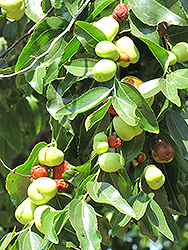It's all about ...
plants

Height: 20 feet
Spread: 15 feet
Sunlight:
![]()
![]()
Hardiness Zone: 6b
Other Names: Jujuba, Red Date, Chinese Date, Korean Date
Description:
This selection produces larger, oblong fruit that is crisp and sweet when yellow-green, becoming chewy and very sweet when ripe; shiny green leaves on pendulous branches appear graceful; suckers aggressively, avoid locating near flowerbeds; very spiny
Ornamental Features
Lang Jujube is primarily grown for its highly ornamental fruit. The fruits are showy dark brown drupes with brick red overtones, which are carried in abundance from late summer to mid fall. The fruit can be messy if allowed to drop on the lawn or walkways, and may require occasional clean-up. It features subtle fragrant white flowers with chartreuse overtones at the ends of the branches from early to mid summer. It has green foliage with light green veins. The serrated oval leaves do not develop any appreciable fall colour.
This plant is primarily grown as an ornamental, but it's also valued for its edible qualities. The large oblong sweet fruit is most often used in the following ways:
- Fresh Eating
- Preserves
- Juice-Making
- Drying
Landscape Attributes
Lang Jujube is a multi-stemmed deciduous tree with a shapely oval form. It lends an extremely fine and delicate texture to the landscape composition which can make it a great accent feature on this basis alone.
This is a high maintenance tree that will require regular care and upkeep, and is best pruned in late winter once the threat of extreme cold has passed. It is a good choice for attracting birds to your yard. Gardeners should be aware of the following characteristic(s) that may warrant special consideration;
- Suckering
- Spiny
Lang Jujube is recommended for the following landscape applications;
- Accent
- Shade
Planting & Growing
Lang Jujube will grow to be about 20 feet tall at maturity, with a spread of 15 feet. It has a low canopy with a typical clearance of 3 feet from the ground, and is suitable for planting under power lines. It grows at a medium rate, and under ideal conditions can be expected to live for 60 years or more. While it is considered to be somewhat self-pollinating, it tends to set heavier quantities of fruit with a different variety of the same species growing nearby.
This tree does best in full sun to partial shade. It prefers to grow in average to dry locations, and dislikes excessive moisture. It is considered to be drought-tolerant, and thus makes an ideal choice for xeriscaping or the moisture-conserving landscape. It is not particular as to soil type or pH. It is somewhat tolerant of urban pollution. This is a selected variety of a species not originally from North America.
This plant is not reliably hardy in our region, and certain restrictions may apply; contact the store for more information.

